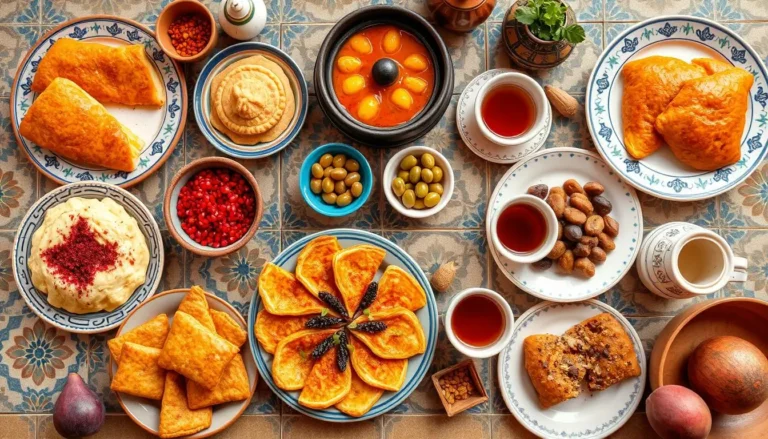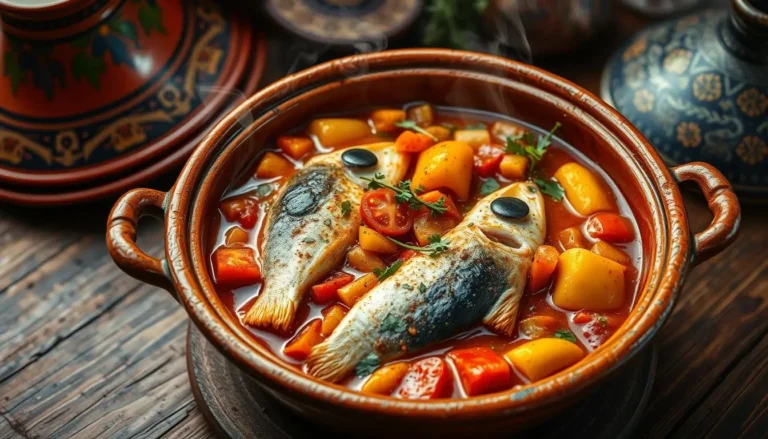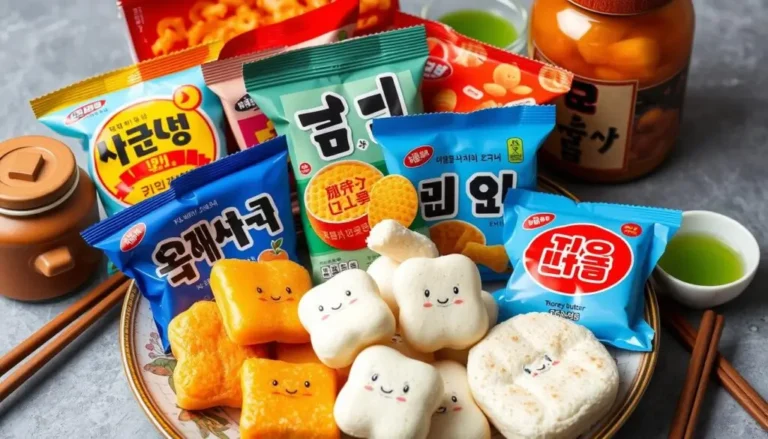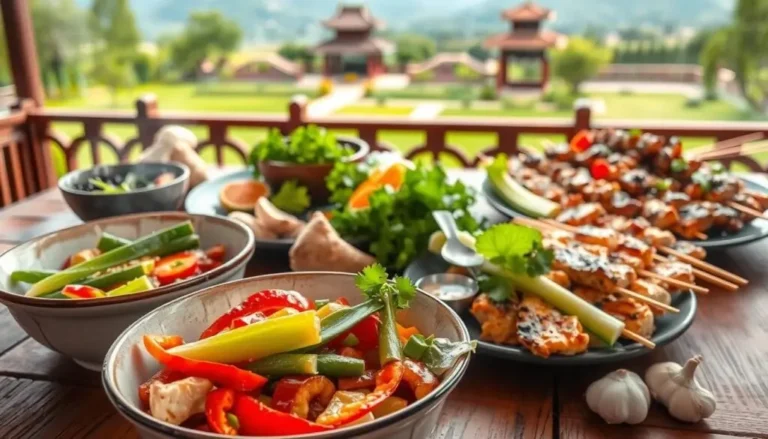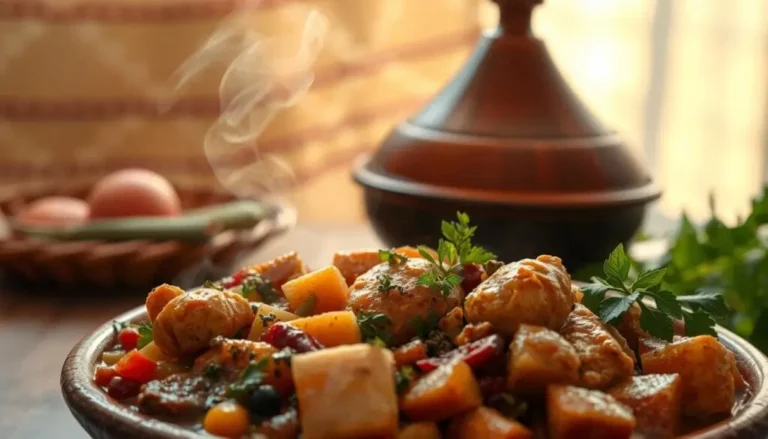Asian Desserts best & Quick recipe
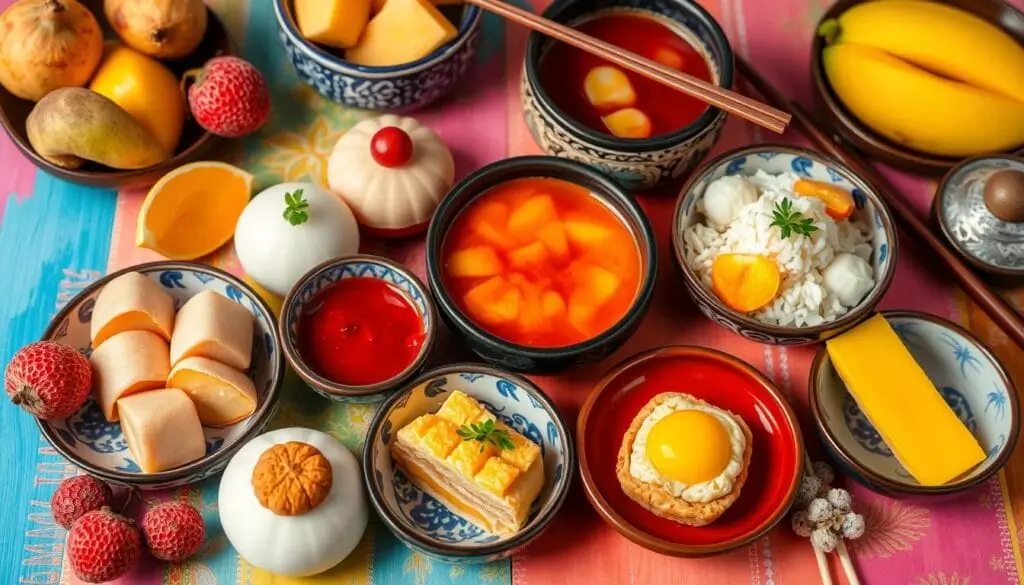
Imagine diving into a world of sweet treats. Here, traditional Asian sweets and popular pastries blend beautifully. You’ll find everything from chewy mochi to creamy mango sticky rice. Plus, many desserts can be made in under an hour, right in your kitchen.
Quick desserts like Taho and Filipino Mango Graham Float need only a few ingredients. Most desserts use 5-7 simple items, making them a breeze to whip up. Whether you crave classic Chinese Almond Cookies or something new like Matcha White Chocolate Cookies, there’s a dessert for you.
Table of Contents
Understanding the World of Asian Desserts
Exploring Asian desserts reveals a rich cultural heritage and diverse traditions. Ingredients like rice flour and coconut milk are key. So are methods like steaming and frying. You can make homemade asian confections and easy asian dessert recipes to enjoy delicious asian treats.
Asian desserts hold great cultural significance. They play big roles in traditional ceremonies and celebrations. For instance, tangyuan (sweet glutinous rice balls) are enjoyed during the Lantern Festival in China, symbolizing family unity. In Japan, desserts like mochi and daifuku highlight minimalism and use seasonal ingredients. You can make these at home with simple easy asian dessert recipes and ingredients like glutinous rice and red bean paste.
Cultural Significance of Asian Sweets
Asian sweets are deeply rooted in the region’s culture, with many desserts dating back thousands of years. Chinese steamed rice cakes were once offerings to deities. In India, jaggery-based sweets have been part of religious ceremonies for centuries. You can learn more about these sweets and try making delicious asian treats at home.
Common Ingredients in Asian Desserts
Asian desserts often use ingredients like rice flour, coconut milk, and sesame seeds. Glutinous rice is key for mochi’s chewy texture. Red bean paste is common in East Asian desserts, found in taiyaki and dorayaki. You can experiment with these ingredients to create your own homemade asian confections and easy asian dessert recipes.
Traditional vs Modern Preparations
Traditional Asian desserts often require a lot of time to prepare. But modern methods have made it easier. Tools like blenders, rice cookers, and microwaves help make traditional desserts at home. Try making modern versions of delicious asian treats using these tools and ingredients like matcha, pandan, and coconut milk.
Essential Tools for Making Asian Desserts
To make tasty asian desserts, you need a few key tools. These tools help you mix ingredients like rice flour and coconut milk. They also ensure your desserts are cooked just right. You’ll need a rice cooker, steamer, and wok.
Having the right tools is crucial for exotic asian desserts. Here are the essential tools to start:
- Rice cooker: perfect for cooking rice and other grains to the right consistency
- Steamer: great for steaming buns and other desserts
- Wok: ideal for stir-frying ingredients and cooking desserts quickly
You’ll also need basic ingredients like sugar, flour, and eggs. With these tools and ingredients, you can make famous asian sweets like mochi and boba.
| Tool | Description |
|---|---|
| Rice Cooker | Perfect for cooking rice and other grains |
| Steamer | Great for steaming buns and other desserts |
| Wok | Ideal for stir-frying ingredients and cooking desserts quickly |
Quick Rice-Based Sweet Treats
Rice is a key ingredient in many Asian desserts. You can make a variety of quick and easy rice-based sweet treats. These popular pastries are great for satisfying your sweet tooth.
Some easy dessert recipes include mochi, rice pudding, and sticky rice desserts. You can make these using simple ingredients and techniques. For example, mochi can be made with glutinous rice flour and red bean paste.
Here are some quick rice-based sweet treats you can try:
- Mochi: a traditional Japanese dessert made with glutinous rice flour and filled with sweet fillings such as red bean paste or ice cream
- Rice pudding: a creamy and comforting dessert made with rice, milk, and sugar
- Sticky rice desserts: a sweet and fragrant dessert made with sticky rice, coconut milk, and sugar
These desserts are not only delicious but also easy to make. With a few simple ingredients and some basic cooking techniques, you can create a variety of popular pastries. So why not try making some easy dessert recipes today and indulge in the sweet side of Asian cuisine?
| Dessert | Ingredients | Preparation Time |
|---|---|---|
| Mochi | Glutinous rice flour, red bean paste, sugar | 30 minutes |
| Rice Pudding | Rice, milk, sugar, cinnamon | 20 minutes |
| Sticky Rice Desserts | Sticky rice, coconut milk, sugar, mango | 40 minutes |
Popular Asian Desserts You Can Make in Minutes
Many think delicious asian treats take a lot of time. But, there are quick exotic asian desserts like mango sticky rice and coconut ice cream. These famous asian sweets are great for a sweet fix.
Some quick Asian desserts include:
- Mango sticky rice: a classic Thai dessert made with fresh mango and coconut milk
- Coconut ice cream: a creamy and refreshing dessert made with coconut milk and a touch of sugar
- Mochi: a Japanese dessert made with glutinous rice flour and filled with sweet fillings such as red bean paste or ice cream
These desserts are tasty and easy to make. They need just a few ingredients. With some practice, you can make these exotic asian desserts at home. You’ll impress everyone with your cooking skills.
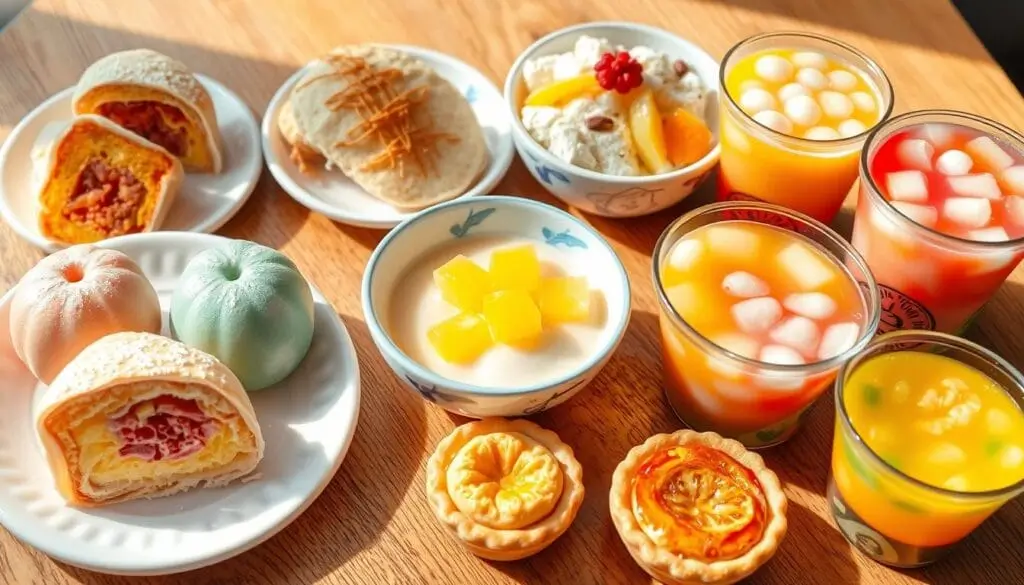
Try these famous asian sweets for their unique tastes and textures. They’re perfect for any event. And they’re quick to prepare, so you can enjoy a delicious Asian dessert fast.
| Dessert | Preparation Time | Servings |
|---|---|---|
| Mango Sticky Rice | 20 minutes | 4-6 servings |
| Coconut Ice Cream | 30 minutes | 6-8 servings |
| Mochi | 45 minutes | 8-10 servings |
Traditional Chinese Sweet Treats
Traditional Chinese desserts use natural ingredients like fruits, nuts, and grains. This shows a focus on plant-based foods. Mooncakes, for example, symbolize reunion and harmony during the Mid-Autumn Festival. Egg tarts, influenced by Portuguese pastries, are now a favorite in Chinese bakeries.
Many people enjoy making traditional desserts like red bean soup and mung bean soup. These are not only tasty but also simple to make. They’re perfect for any occasion. Quick dumplings are another popular treat in Chinese cuisine.
Almond jelly is a traditional dessert with sweet apricot kernels. It has kept its recipe for centuries. Soy Milk Pudding has also become popular, especially for vegans. You can make these desserts at home with simple ingredients and recipes.
| Dessert | Ingredients | Occasion |
|---|---|---|
| Mooncakes | Lotus seed paste, bean paste, fruit, salted egg yolks | Mid-Autumn Festival |
| Egg Tarts | Eggs, sugar, flour, milk | Any occasion |
| Almond Jelly | Almond flour, sugar, apricot kernels | Any occasion |
Japanese Sweet Confections
Japanese desserts are simple yet elegant. They often use natural ingredients like rice flour and red bean paste. You can try making easy asian dessert recipes like mochi, manju, and daifuku. These are beloved Japanese sweets.
Some popular Japanese desserts include:
- Mochi: a traditional Japanese sweet made from pounded sticky rice
- Manju: a steamed bun filled with sweet red bean paste
- Daifuku: a glutinous rice cake filled with sweet bean paste or ice cream
Thesedelicious asian treats are great for special occasions or as a sweet snack.
Looking to try something new? There are many exotic asian desserts to explore. Try making your own Japanese-style desserts at home. Use easy asian dessert recipes and ingredients like matcha powder and red bean paste.
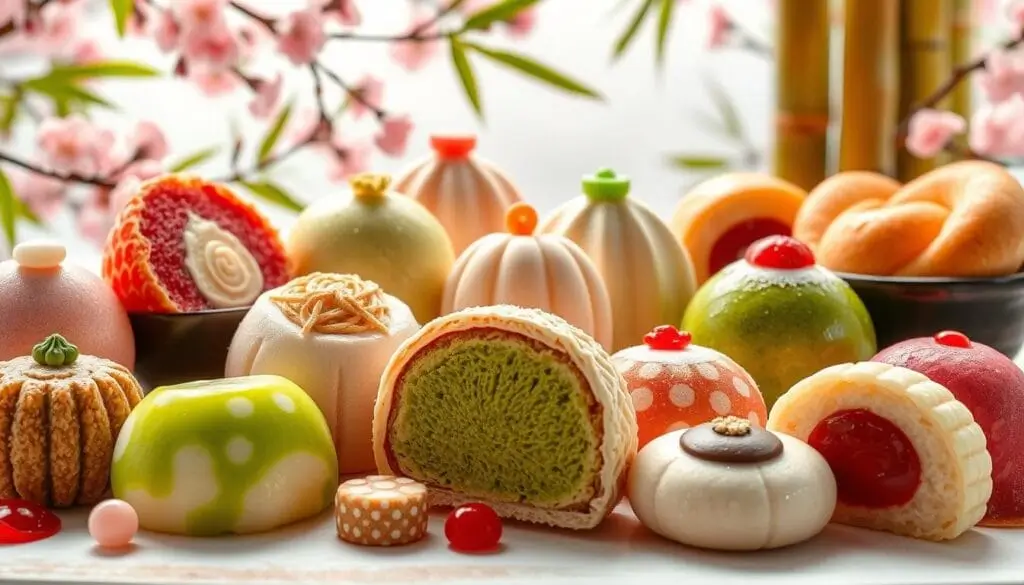
With so many options, you’re sure to find a Japanese dessert you’ll love. Whether you like traditional sweets like mochi and manju or modern treats like mochi ice cream, there’s something for everyone.
Korean Dessert Favorites
Korean desserts mix old and new flavors. You can try bingsu and traditional tea cookies. These treats are great for special times.
In Korea, desserts are a big part of life. Street cafes and bakeries offer many sweet treats. Bingsu, with its shaved ice and sweet toppings, is a favorite.
Bingsu Variations
Bingsu has many flavors, like patbingsu and mango bingsu. These desserts use simple ingredients but taste amazing. They’re perfect for hot days.
Traditional Tea Cookies
Korean tea cookies are loved by many. They’re made with flour, sugar, and tea. You can find them in green or black tea flavors.
Modern Korean sweets like cheesecake and ice cream are also popular. They offer something new and exciting. With so many choices, you’re bound to find something you like.
Southeast Asian Sweet Delicacies
Exploring exotic Asian desserts reveals a world of famous sweets and treats. Southeast Asia, with its vibrant desserts, stands out. Countries like Thailand, Vietnam, and Indonesia offer unique and delicious desserts.
Coconut milk is a key ingredient in many Southeast Asian desserts. It adds a rich, creamy texture. For example, ondeh ondeh, a traditional Malaysian dessert, uses coconut milk and gula melaka, a type of palm sugar. Pandan extract is also popular, enhancing flavors in desserts like kuih lapis, a layered pastry.
Some popular Southeast Asian desserts include:
- Bua Loy, tender and springy glutinous rice balls served in sweetened coconut milk
- Badak Berendam, larger glutinous rice flour balls filled with grated coconut and palm sugar, served in coconut milk thickened with rice flour
- Tang Yuan, a traditional dessert made with glutinous rice flour, often served during the winter solstice to celebrate family reunion
These desserts are not just tasty but also showcase Southeast Asia’s rich culture. Their unique flavors and ingredients make them a favorite among those who try them.
| Dessert | Ingredients | Country of Origin |
|---|---|---|
| Ondeh Ondeh | Glutinous rice flour, coconut milk, gula melaka | Malaysia |
| Bua Loy | Glutinous rice flour, coconut milk, palm sugar | Thailand |
| Tang Yuan | Glutinous rice flour, coconut milk, palm sugar | China/Indonesia |
Easy No-Bake Asian Desserts
No-bake desserts are perfect for hot summer days. They are quick and easy to make. Many Asian pastries and confections can be made without baking.
Puddings and jellies, like mango pudding or coconut jelly, are great examples. They need just a few ingredients. You can also try halo-halo, a Filipino dessert, or patbingsu, a Korean one.
To make these desserts, use coconut milk, mango, and sweetened beans. Add evaporated milk, ice cream, and fresh fruit for extra flavor and texture. Enjoy the sweet and creamy flavors of Asia without spending hours cooking.
Here are some tips for making easy no-bake Asian desserts:
- Use high-quality ingredients, such as fresh fruit and real coconut milk, to give your desserts the best flavor and texture.
- Experiment with different toppings and ingredients to find the combination that you like best.
- Don’t be afraid to try new things and make mistakes – it’s all part of the learning process!
Fusion Asian Dessert Ideas
Exploring exotic Asian desserts opens up a world of unique flavors. Fusion desserts mix traditional Asian tastes with modern twists. Try matcha cupcakes for a bright green tea flavor or black sesame ice cream for a nutty twist.
Famous sweets like mochi and red bean paste add texture and taste to fusion desserts. Imagine mochi cake with red bean paste inside or mochi on top of ice cream. Desserts like mango sticky rice and coconut rice pudding can also get a modern twist with tropical fruits or nuts.
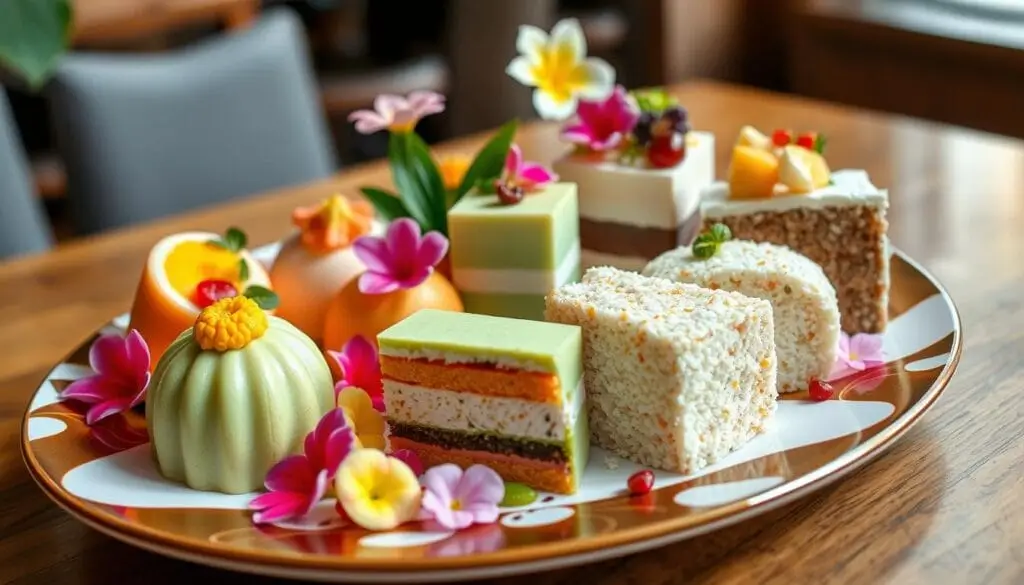
- Play with ingredients like matcha, sesame, and coconut for new flavors.
- Blend traditional desserts with fruits or nuts for extra texture and taste.
- Be bold and try new things. Fusion desserts are all about creativity and experimentation.
With creativity and a bit of experimentation, you can make unique fusion desserts. They combine the best of exotic Asian flavors with modern ingredients. Whether you’re an experienced baker or just starting, fusion desserts are a fun way to explore tasty Asian treats.
Common Mistakes to Avoid When Making Asian Desserts
When you make homemade Asian desserts, knowing common mistakes is key. The right ingredients and techniques are crucial for the perfect texture and flavor. This ensures your desserts turn out just right.
One big mistake is substituting ingredients. For instance, using coconut cream instead of milk makes desserts thicker and more calorie-rich. Also, not mixing or cooking ingredients right can mess up the texture.
Ingredient Substitutions
- Using high-fat coconut milk can lead to layering in traditional recipes
- Substituting gelatin with agar can result in a more bland final product
- Using sugar substitutes can affect the flavor and appearance of the dessert
Texture Problems
To avoid texture issues, stick to the recipe and use the correct ingredients. For example, the right flour and starch are essential for desserts like Vietnamese Pandan waffles. Also, proper cooking and cooling prevent texture problems.
Knowing these common mistakes helps you make delicious homemade Asian desserts. With practice and patience, you’ll master easy Asian dessert recipes. Enjoy the amazing flavors and textures of Asian cuisine.
| Dessert | Common Mistakes | Tips to Avoid |
|---|---|---|
| Coconut Pudding | Using high-fat coconut milk | Use low-fat coconut milk and follow the recipe carefully |
| Pandan Waffles | Using the wrong type of flour | Use a combination of tapioca starch and rice flour for the right texture |
Storage Tips for Asian Sweet Treats
Storing popular Asian pastries, homemade confections, and tasty desserts right is key. It helps keep them fresh and tasty longer. Here are some tips to help you store your desserts well:
For items like fresh herbs, sturdy greens, and fruits, the right storage makes a big difference. For instance, fresh herbs can stay fresh for up to three weeks in mason jars with water. Apples can last up to a week at room temperature and several weeks in the fridge’s fruit drawer.
Here are some more storage tips for ingredients often used in Asian desserts:
- Store mochi and rice cakes in airtight containers to keep them fresh and soft.
- Keep garlic and onions in a cool, dark spot to keep their flavor strong.
- Store ginger in the fridge’s veggie drawer or freeze it for later.
By using these storage tips, you can enjoy your favorite Asian desserts for longer. Always check the freshness and quality of your ingredients before using them.
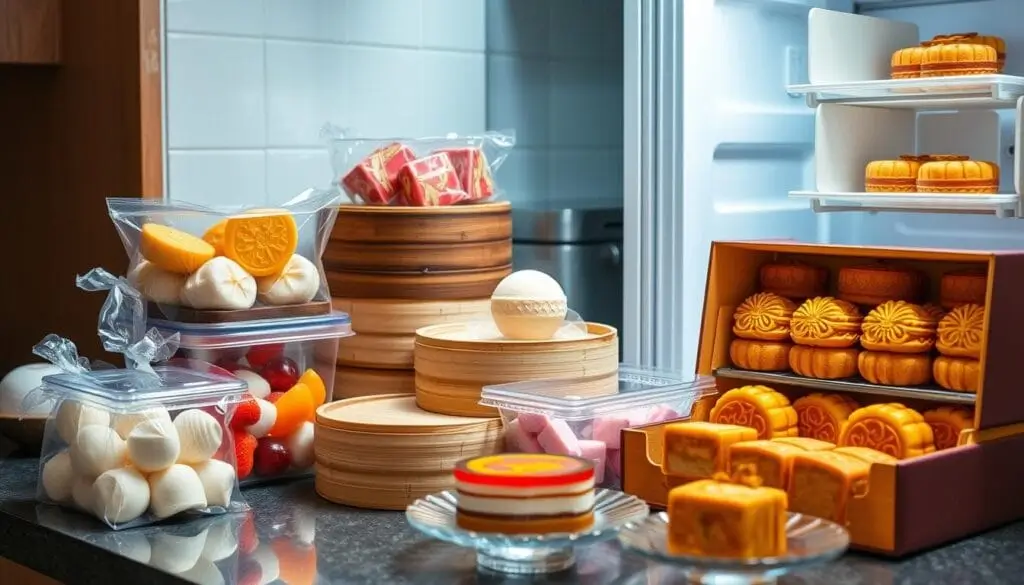
With the right storage, you can keep your Asian desserts fresh and delicious. This way, they’ll always be a joy to eat.
| Ingredient | Storage Method | Shelf Life |
|---|---|---|
| Fresh Herbs | Mason jars with water | Up to 3 weeks |
| Apples | Room temperature or refrigerator | Up to 1 week (room temperature), several weeks (refrigerator) |
| Garlic and Onions | Cool, dark place | Up to 1 month |
Where to Find Authentic Asian Dessert Ingredients
Making exotic Asian desserts needs the right ingredients. Famous Asian sweets often require unique, authentic ingredients. Luckily, online shopping and specialty stores make it easier to find these.
For delicious Asian treats, search online for Asian ingredient retailers. Amazon and Asianfoodgrocer are good places to start. You can also visit local Asian grocery stores, which usually have a wide selection.
Here are some places to find authentic Asian dessert ingredients:
- Amazon: Offers a wide selection of Asian ingredients, including hard-to-find spices and sauces.
- Asianfoodgrocer: Specializes in Asian ingredients and offers a wide range of products, including snacks and spices.
- Local Asian grocery stores: Often carry a wide range of ingredients and spices, and staff may be able to offer advice and recommendations.
By exploring these options, you can find the authentic ingredients for exotic Asian desserts and famous sweets. With patience and persistence, you can make delicious treats that will wow your friends and family.
| Ingredient | Online Resource | Asian Grocery Store |
|---|---|---|
| Rice flour | Amazon | Local Asian market |
| Coconut milk | Asianfoodgrocer | Specialty food store |
| Sesame seeds | Amazon | Local health food store |
Conclusion: Embracing the Sweet Side of Asian Cuisine
As we wrap up our exploration of Asian desserts, it’s clear that Asian sweets are a treasure trove. From classic traditional Asian sweets like mochi to modern popular Asian pastries, there’s a treat for everyone. Each dessert offers a unique taste and story.
Exploring Asian desserts introduces you to new flavors and cultures. Whether you love Japanese wagashi or Korean bingsu, there’s always something new to try. It’s a chance to broaden your culinary world and appreciate Asian cuisine’s rich heritage and creativity.
Don’t be shy to try these tasty treats. With the right ingredients and practice, you can make Asian desserts at home. It’s a journey that’s as exciting as the desserts themselves. So, go ahead and explore the world of traditional Asian sweets and popular Asian pastries.
FAQ
What are the essential tools for making Asian desserts?
What are the common ingredients used in Asian desserts?
What are some popular Asian rice-based sweet treats?
What are some easy no-bake Asian desserts?
Where can I find authentic Asian dessert ingredients?
What are some common mistakes to avoid when making Asian desserts?
How should I store Asian sweet treats?
Have you cooked any of our recipes yet?
There are no reviews yet. Be the first one to write one.

